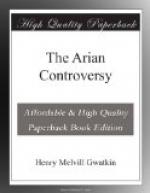The remaining canons are mostly aimed at the disorders which had grown up during the reign of Valens. One of them checks the reckless accusations which were brought against the bishops by ordering that no charge of heresy should be received from heretics and such like. Such a disqualification of accusers was not unreasonable, as it did not apply to charges of private wrong; yet this clerical privilege grew into one of the worst scandals of the Middle Ages. The forged decretals of the ninth century not only order the strictest scrutiny of witnesses against a bishop, but require seventy-two of them to convict him of any crime except heresy. Another canon forbids the intrusion of bishops into other dioceses. ’Nevertheless, the bishop of Constantinople shall hold the first rank after the bishop of Rome, because Constantinople is New Rome.’ This is the famous third canon, which laid a foundation for the ecclesiastical authority of Constantinople. It was extended at Chalcedon [Sidenote: 451.] into a jurisdiction over the whole country from Mount Taurus to the Danube, and by Justinian into the supremacy of the East. The canon, therefore, marks a clear step in the concentration of the Eastern Church and Empire round Constantinople. The blow struck Rome on one side, Alexandria on the other. It was the reason why Rome withheld for centuries her full approval from the council of Constantinople. [Sidenote: 1215.] She could not safely give it till her Eastern rival was humiliated; and this was not till the time of the Latin Emperors in the thirteenth century.
[Sidenote: Second edict defining orthodoxy.]
The council having ratified the Emperor’s work, it only remained for the Emperor to complete that of the council. A new edict in July forbade Arians of every sort to build churches. Even their old liberty to build outside the walls of cities was now taken from them. At the end of the month Theodosius issued an amended definition of orthodoxy. Henceforth sound belief was to be guaranteed by communion, no longer with Rome and Alexandria, but with Constantinople, Alexandria, and the chief bishoprics of the East. The choice of bishops was decided partly by their own importance, partly by that of their sees. Gregory of Nyssa may represent one class, Helladius of Caesarea the other. The omissions, however, are significant. We miss not only Antioch and Jerusalem, but Ephesus and Hadrianople, and even Nicomedia. There is a broad space left clear around the Bosphorus. If we now take into account the third canon, we cannot mistake the Asiatic policy of endeavouring to replace the primacy of Rome or Alexandria by that of Constantinople.
[Sidenote: The Novatians.]
The tolerance of Theodosius was a little, though only a little, wider than it seems. Though the Novatians were not in communion with Nectarius, they were during the next half century a recognised exception to the persecuting laws. They had always been sound as against Arianism, and their bishop Agelius had suffered exile under Valens. His confession was approved by Theodosius, and several of his successors lived on friendly terms with liberal or worldly patriarchs like Nectarius and Atticus. They suffered something from the bigotry of Chrysostom, something also from the greed of Cyril, but for them the age of persecution only began with Nestorius in 428.




